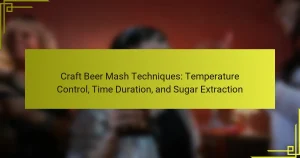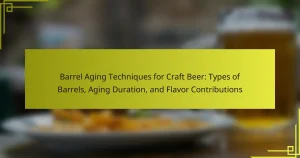Dry hopping is a brewing technique employed in craft beer production to enhance aroma and flavor without adding significant bitterness. This process involves adding hops after boiling, typically during fermentation or conditioning, resulting in pronounced hop characteristics such as floral, fruity, or citrusy notes. The article explores various dry hopping methods, including the traditional method, hop bags, and hop pellets, each offering unique advantages for flavor extraction. Additionally, it highlights the impact of dry hopping on the perceived freshness of beer and its role in creating complex flavor profiles, particularly in hop-forward styles like IPAs.

What is Dry Hopping in Craft Beer?
Dry hopping is a brewing technique used in craft beer to enhance aroma and flavor. It involves adding hops to the beer after the boiling process, typically during fermentation or conditioning. This method allows volatile hop oils to infuse the beer without contributing significant bitterness. Dry hopping can result in a more pronounced hop character, often described as floral, fruity, or citrusy. Many brewers employ this technique to create hop-forward styles like IPAs. Research indicates that dry hopping can increase the perception of freshness in beer, making it a popular choice among craft brewers.
How does Dry Hopping differ from Traditional Hopping?
Dry hopping differs from traditional hopping primarily in timing and method of addition. Traditional hopping involves adding hops during the boiling phase of brewing. This process extracts bitterness and some aroma from the hops. In contrast, dry hopping occurs after the boil, typically during fermentation. This method enhances the aroma without significantly increasing bitterness. Studies show that dry hopping can contribute to a more pronounced hop aroma, as it preserves volatile compounds that would otherwise be lost in boiling. This technique is commonly used in craft beer to achieve complex flavor profiles.
What are the key processes involved in Dry Hopping?
The key processes involved in dry hopping include selecting the hops, adding them to the beer, and allowing time for extraction. Selecting the hops involves choosing varieties that impart desired flavors and aromas. Hops can be added during fermentation or conditioning stages. The addition typically occurs in the fermentation vessel. The process allows for volatile oils from hops to infuse into the beer. Timing is crucial; common durations range from a few days to several weeks. The temperature during dry hopping also affects extraction efficiency. Cooler temperatures preserve delicate hop aromas while warmer temperatures enhance extraction.
Why is Dry Hopping important for craft beer?
Dry hopping is important for craft beer because it enhances aroma and flavor without adding bitterness. This technique involves adding hops during fermentation or conditioning. The process allows volatile oils from hops to infuse into the beer. As a result, dry hopping contributes to a more complex flavor profile. Many craft brewers utilize this method to create unique and aromatic brews. Studies show that dry hopping can significantly increase hop aroma perception. This practice has become a hallmark of many popular craft beer styles.
What are the benefits of Dry Hopping?
Dry hopping enhances the aroma and flavor of craft beer. It introduces hop oils without adding bitterness. This process allows for a more pronounced hop character. Dry hopping can lead to a fresher and more vibrant taste profile. It also helps in creating complex flavor layers. Studies show that dry hopping increases the perception of hop aroma significantly. For example, a study published in the Journal of the American Society of Brewing Chemists found that dry hopping can elevate the aroma intensity by up to 50%. Additionally, dry hopping can improve the overall mouthfeel of the beer.
How does Dry Hopping enhance flavor profiles?
Dry hopping enhances flavor profiles by infusing aromatic hop compounds into beer without adding bitterness. This process involves adding hops during fermentation rather than during the boil. The timing and method of dry hopping can significantly impact the aroma and flavor characteristics. Commonly used hops in dry hopping include varieties known for their floral, citrus, or tropical fruit notes.
Research shows that dry hopping can lead to increased levels of volatile compounds, which contribute to the overall aroma. A study published in the Journal of the American Society of Brewing Chemists indicates that dry hopping can improve the perception of freshness in beer. This results in a more complex and enjoyable drinking experience.
What impact does Dry Hopping have on aroma?
Dry hopping significantly enhances the aroma of craft beer. This process involves adding hops during fermentation or conditioning. It introduces volatile aromatic compounds from the hops into the beer. These compounds contribute floral, citrus, and herbal notes. Research shows that dry hopping can increase hop aroma intensity. A study published in the Journal of the American Society of Brewing Chemists found that dry hopping can elevate aroma perception by up to 40%. The timing and method of dry hopping also influence the final aroma profile. Overall, dry hopping is essential for achieving a vibrant hop aroma in craft beer.

What Methods are Used for Dry Hopping?
Common methods for dry hopping include the traditional method, hop bags, and hop pellets. The traditional method involves adding whole hops directly to the fermentation vessel. This method allows for maximum oil extraction. Hop bags are used to contain the hops, making removal easier after the desired flavor is achieved. This method reduces the risk of hop debris in the final product. Hop pellets are small, compressed hop cones. They dissolve more readily and can increase hop utilization. Each method has its own advantages, impacting flavor and aroma differently.
What are the different Dry Hopping techniques?
The different dry hopping techniques include traditional dry hopping, hop bursting, and biotransformation hopping. Traditional dry hopping involves adding hops during fermentation to enhance aroma. This method allows for a gradual extraction of hop oils. Hop bursting adds a large amount of hops late in the boil or during fermentation. This technique maximizes hop flavor and aroma without increasing bitterness. Biotransformation hopping introduces hops during fermentation to interact with yeast. This interaction can create unique flavors and aromas. Each technique varies in its impact on the final beer profile, influencing aroma and flavor complexity.
How do you choose between different Dry Hopping methods?
Choosing between different dry hopping methods depends on desired flavor profile, aroma intensity, and brewing equipment. First, consider the hop variety and its characteristics. Some hops provide citrus notes, while others offer herbal or floral aromas. Next, evaluate the timing of dry hopping. Methods such as whirlpool hopping can enhance aroma without excessive bitterness. Additionally, consider the temperature during dry hopping; lower temperatures preserve volatile oils better.
Research indicates that dry hopping during fermentation can lead to different flavor outcomes compared to post-fermentation hopping. A study published in the Journal of the American Society of Brewing Chemists found that timing and method significantly affect hop utilization. Finally, assess your brewing setup. Some methods require specific equipment, like a hop cannon or a keg with a dry hopping port.
What equipment is necessary for effective Dry Hopping?
For effective dry hopping, a few essential pieces of equipment are necessary. A hop bag or mesh bag is crucial for containing the hops during the process. This prevents unwanted particles from entering the final product. A fermentation vessel is also needed to hold the beer as it undergoes dry hopping. This vessel should be airtight to maintain the beer’s environment. A stirring tool can help to evenly distribute the hops in the liquid. Additionally, a thermometer is useful to monitor the temperature during the dry hopping phase. Finally, a hydrometer can measure the specific gravity before and after dry hopping. These tools together ensure a successful dry hopping process, enhancing the beer’s flavor.
How does timing affect Dry Hopping outcomes?
Timing significantly affects dry hopping outcomes in craft beer. The timing of adding hops influences the aroma and flavor profile. Early dry hopping can lead to a more pronounced bitterness. Conversely, late dry hopping enhances the aromatic qualities without adding bitterness. Research indicates that hops added closer to fermentation’s end yield fresher hop aromas. A study by the American Society of Brewing Chemists shows that hops added during active fermentation produce unique flavor compounds. Therefore, precise timing is crucial for achieving desired sensory characteristics in the final product.
When is the best time to add hops during the brewing process?
The best time to add hops during the brewing process is at three key stages: the beginning of the boil, midway through the boil, and at the end of the boil. Adding hops at the beginning of the boil contributes to bitterness. This is when the hops are boiled for the longest duration, allowing for the extraction of alpha acids. Midway through the boil adds flavor to the beer. This timing balances bitterness and flavor. Adding hops at the end of the boil enhances aroma. This method preserves volatile oils that contribute to the hop’s fragrance. Each timing method serves a specific purpose in developing the beer’s overall profile.
What factors should influence your Dry Hopping schedule?
The dry hopping schedule should be influenced by the desired flavor profile and aroma intensity. Different hop varieties impart unique characteristics. The timing of dry hopping affects the extraction of essential oils. Early dry hopping can enhance bitterness, while late additions focus on aroma. The fermentation stage also plays a role; dry hopping during active fermentation can yield different results than post-fermentation. The duration of contact time with the hops is crucial; shorter times can lead to fresher aromas. Lastly, the specific beer style should guide the dry hopping approach, as different styles benefit from varying hop intensities.

What Flavor Enhancements Can be Achieved through Dry Hopping?
Dry hopping enhances flavor by adding aromatic compounds to beer. This process introduces various hop oils, which contribute to the beer’s aroma and taste profile. Common flavor enhancements include citrus, floral, and herbal notes. These characteristics improve the overall sensory experience. Research indicates that dry hopping can increase perceived freshness in beer. Studies show that dry hopping can elevate hop aroma intensity significantly. This method also allows for a more complex flavor profile without increasing bitterness. Overall, dry hopping is crucial for achieving desired flavor enhancements in craft beer.
What specific flavors can be derived from different hop varieties?
Different hop varieties produce a wide range of specific flavors in craft beer. For example, Cascade hops impart floral and citrus notes, particularly grapefruit. Citra hops are known for their strong tropical fruit flavors, including lime and passionfruit. Simcoe hops offer a complex profile of pine and apricot. Amarillo hops provide orange and floral characteristics, enhancing aroma. Centennial hops are often described as having a balanced profile of citrus and floral notes. Mosaic hops deliver a unique blend of tropical and earthy flavors, including blueberry. Each hop variety contributes distinct attributes that enhance the overall flavor profile of the beer. These flavors are essential in crafting diverse and appealing craft beers.
How do hop characteristics influence the final beer taste?
Hop characteristics significantly influence the final beer taste. Different hop varieties impart unique flavors and aromas, such as citrus, pine, or floral notes. The alpha acid content in hops affects bitterness levels in beer. Higher alpha acids lead to increased bitterness, balancing the sweetness of malt. The timing of hop addition during brewing also alters taste profiles. Early additions enhance bitterness, while late or dry hopping emphasizes aroma and flavor. The oil composition in hops contributes to the overall sensory experience. Terpenes found in hops further enhance specific flavor characteristics. Studies show that hop selection is crucial for achieving desired taste outcomes in craft beer.
What are some common flavor profiles achieved through Dry Hopping?
Common flavor profiles achieved through dry hopping include citrus, pine, floral, and tropical fruit notes. Citrus flavors often resemble orange, grapefruit, or lemon. Pine notes provide a resinous character, commonly associated with certain hop varieties. Floral profiles can evoke aromas similar to jasmine or lavender. Tropical fruit flavors may include mango, pineapple, or passion fruit. These profiles result from the volatile aromatic compounds released during the dry hopping process. Research shows that specific hop varieties contribute distinct flavor characteristics. For instance, Citra hops are known for their strong citrus and tropical fruit aromas.
How can brewers optimize their Dry Hopping techniques?
Brewers can optimize their dry hopping techniques by adjusting the timing, temperature, and hop variety used. Timing is crucial; adding hops during fermentation can enhance aroma and flavor. Brewers often use late hopping or hop bursting to maximize these effects. Temperature also plays a role; dry hopping at cooler temperatures can preserve volatile aromatics. Selecting the right hop variety is essential, as different hops impart unique flavors and aromas. For instance, citrus-forward hops like Citra can provide distinct profiles. Additionally, the use of hop pellets versus whole hops can influence extraction rates. Research shows that optimizing these factors can improve the overall hop character in the final beer.
What are some best practices for successful Dry Hopping?
Successful dry hopping involves several best practices. First, choose high-quality hops that match the desired flavor profile. Second, add hops at the right time, typically during fermentation, to maximize aroma. Third, use the correct quantity; a common range is 0.5 to 2 ounces per gallon. Fourth, maintain optimal fermentation temperatures to preserve hop oils. Fifth, consider using a hop bag to minimize sediment. Lastly, experiment with different hop varieties to discover unique flavors. These practices enhance aroma and flavor in craft beer, leading to a better final product.
How can common Dry Hopping challenges be addressed?
Common dry hopping challenges can be addressed through several strategies. First, optimizing hop selection is crucial. Choosing the right hop variety can enhance aroma and flavor while minimizing undesirable characteristics. Second, controlling the timing of dry hopping is essential. Adding hops at different stages of fermentation can impact the final flavor profile. Third, managing temperature during dry hopping can help preserve volatile oils. Conducting dry hopping at cooler temperatures often results in better aroma retention. Fourth, using a hop bag or mesh can prevent excessive sediment and facilitate easier filtration. Lastly, monitoring the amount of hops used is important. Over-hopping can lead to astringency and imbalance in the beer’s flavor. Implementing these strategies can significantly improve the dry hopping process and overall beer quality.
The main entity of the article is dry hopping, a brewing technique in craft beer that enhances aroma and flavor without adding bitterness. The article provides a comprehensive overview of dry hopping methods, including traditional dry hopping, hop bursting, and biotransformation hopping, along with the importance of timing and temperature in the process. It discusses the key benefits of dry hopping, such as increased hop aroma intensity and the ability to create complex flavor profiles, while also addressing best practices and common challenges faced by brewers. Additionally, the article highlights the specific flavors derived from different hop varieties and how these characteristics influence the final beer taste.




